Jerng: The Martial Art of Northern Thailand
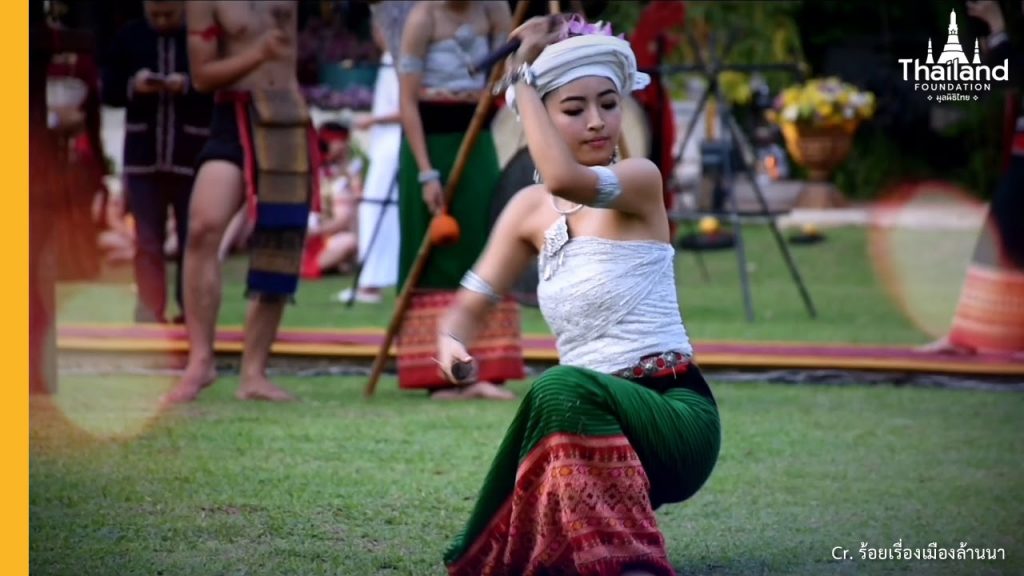
When talking about Thai martial arts, the first name most Thais and foreigners think of is Muay Thai and its predecessor Muay Boran. However, if you have followed our article series on the Thai martial arts, you must have learned of at least one more name, which is Krabi-Krabong, or the Thai art of swords and staffs. Today, we will introduce you to another rare martial art form from Northern Thailand. Let’s talk about the majestic yet aesthetic art of Jerng.
Identity: Beauty and Strength
Jerng is the martial art of Northern Thailand. The word “jerng” (เจิง) is a Northern Thai word meaning “tactics” or “finesse.” Long before becoming part of Thailand, the Northern territory of Thailand was its own political entity, known as the Kingdom of Lanna. The people of Lanna were skillful fighters who developed combat skills to protect their home and fend off enemies. Over centuries, their combatting techniques had been refined and compilled into the art of Jerng. In addition to the Thai people, other ethnic groups in Lanna, such as the Tai Yai and Tai Lue, also practice their versions of Jerng.
Jerng is both as precise and deadly as it is charming and graceful, reflecting the typical culture of the Northern Thai people, who are known for their love for beauty and aesthetics. The intricate, often confusing, moves of the martial art make up a realm of mind game between opponents. When not engaging is combat, fighters may demonstrate their martial prowess through a dance known as “Forn Jerng” (ฟ้อนเจิง), with the word “forn” (ฟ้อน) meaning “a dance or to dance”.
Besides being a hand-to-hand combat, Jerng also integrates weapons. These include sword, spear, staff, and pole weapons, among others. There are, therefore, two types of Forn Jerng that fighters can perform: the barehanded dance and the weapon dance, which involves either spear, sword, or wooded staff.
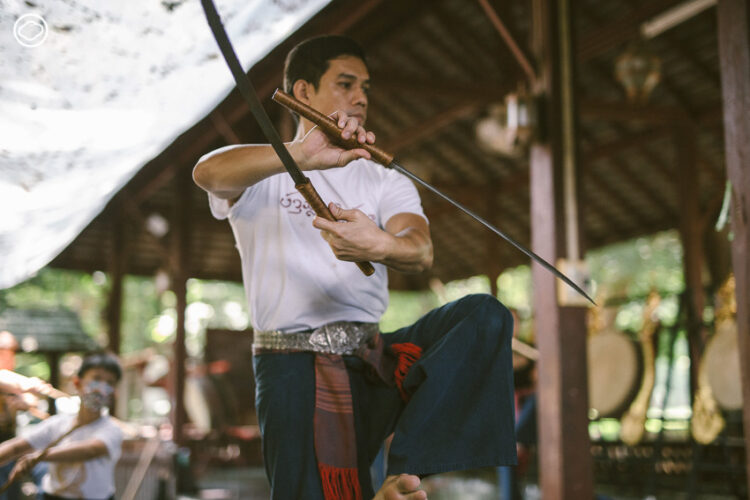
(Photo Credit: The Cloud)
Wai Khru: the Quintessential Ceremony of Thai Arts
If you want to learn Jerng, you cannot simply go to a teacher and expect to enroll on the spot. Instead, you must first perform the ritual of Wai Khru to pay respect to the teachers of Jerng. Those who wish to learn the art have to visit the teacher on an auspicious day. They must bring offerings for the teacher, which include flower cones, joss sticks, betel nuts, milled rice, paddies, liquor, white cloth, red cloth, bananas, sugar canes, coconuts, and a tuition fee. If you are lucky, a teacher may welcome you as a student after the ceremony, but some teachers have an additional screening protocol. Some will perform a sacrificing ceremony to ask deities if he should accept a certain person as a student. Some teachers will take their potential students for a walk in the forest to see if they are courageous and patient enough. If they pass the test, they will be accepted as students. After training, even after the students have learned all that they need to know, they should still visit their teacher every year to express their gratefulness to the teacher and the art.
Before every Jerng performance, one must perform the Wai Khru Dance to pay respect to teachers and deities (much like the Wai Khru Ram Muay dance in Muay Thai). The process starts with crossing the swords on the ground, turning the sharp edges outside. If the performer is a man, walk around the crossed swords one time, and perform “Top Maphap” (ตบมะผาบ) which will be discussed shortly. He will then sit down and do the wai (ไหว้), a signature Thai greeting. If the performer is a woman, she will follow the man’s version, but will do the wai three times. The second part is to pick up the swords from the ground, cross them at one’s forehead, raise one’s head up, and then look down. Now cross the swords behind one’s back, bring them forward and put them back again. Repeat the last movement three time, starting with the front direction, before turning to the right, and left, respectively.

(Photo Credit: พุทธวงศ์ เอกพจน์ Puttawong Ekkapoj)
Techniques
Jerng is the art of tricking your enemy into revealing his weaknesses. In the past, warriors often wore armors to protect themselves from piercing swords. Some types of armor seem impenetrable but Forn Jerng performed before the real fighting will force the opponent to move and disclose any unprotected parts, often at the armpits where there is no armor. In the real battle, the opponent can navigate the sword through the space at the armpit and attack the opponent’s head without having to break the armor. In this sense, Jerng is more strategic than aesthetic.
The three components of Jerng include:
- The footwork is called “Yang Khum” (ย่างขุม). This is the walking steps of Forn Jerng, with “yang” (ย่าง) meaning “to step” and “khum” (ขุม) meaning “walking pattern”. Yang Khum can be as easy as a one-step walk pattern or as perplexing as a 32-step walk pattern. The walking patterns are the top secret of Forn Jerng and must not be revealed to outsiders. Only after have the students completed the footwork, the teacher will teach the handwork.
- The handwork is called “Top Maphap” (ตบมะผาบ). It is the use of hands to clap and slap the body to make a loud sound like firecrackers. This handwork is performed with bare hands to provoke an opponent. Back in the day, warriors in the Lanna region wielded short-ranged weapons, and they would perform a sword dance with their opponents either in pair or in group. Whoever had a better technique won. The hand moves are a psychic battle, and those who cannot control their mind will lose to those who are calm and composed. The claps and slaps also help to invigorate the performers themselves, intimidate the opponents, and warm up the fighters before the actual fight. This handwork is mesmerizing, and if the performer knows any prayers or spells, he can chant them along with the claps and slaps, making it look like casting a spell.
- The standard moves are called “Mae Lai” (แม่ลาย). Each Jerng teacher has their own unique moves and patterns, but there are two standard moves, called “Bit Bua Ban” (บิดบัวบาน), which means “twisting the blooming lotus” and “Kiao Klao” (เกี้ยวเกล้า), which means “making a hair bun”. Both moves involve twisting the wrists and arms to make a hoop shape. The “Kiao Klao” posture requires a whole-body movement while the “Bit Bua Ban” moves only hands, but both are equally delicate. Once the students are familiar with bare hand moves, they can learn to perform with weapons like swords, spears and sticks, which are less agile than the bare hand moves. After mastering Jerng to the point that they can use it to defend themselves, the students will learn the ultimate moves, or the deadly moves. The teacher select and teach the deadly move that fits the character of each student. The ultimate moves are called “Mae Pod” (แม่ป็อด).
Forn Jerng (ฟ้อนเจิง) and Forn Daab (ฟ้อนดาบ)
Forn Jerng, or Jerng Dance, was a common sight in ancient Northern Thailand. Fighters often perform the dance in public spaces to measure each other’s skills and impress the ladies. Today, Forn Jerng are often performed during cultural celebrations and to welcome tourists. Two types of Forn Jerng are popular: the barehanded Forn Jerng and the sword dance known as “Forn Jerng Daab” (ฟ้อนเจิงดาบ), or “Forn Daab” (ฟ้อนดาบ) for short. Both dances share similar patterns, but can branch out extensively and differ in styles according to each different teacher.
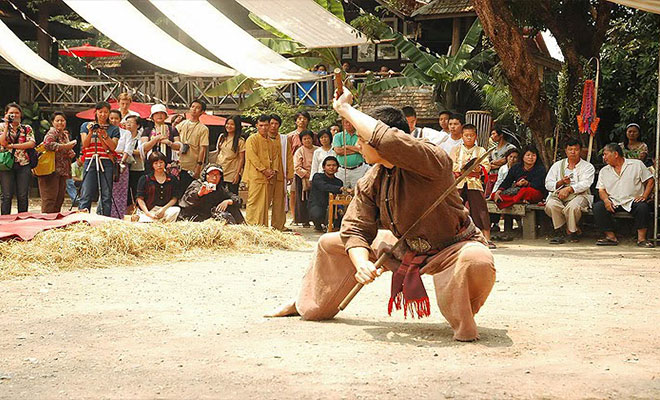
(Photo Credit: At-Chiangmai)
Forn Daab has dozens of styles, such as Cherng Saen sword dance, which is originated in Northern Thailand, or Saenwie sword dance created by the Tai Yai or Shan people, who are regarded as one of the best swordfighters in Northern Thai history. The dance is often accompanied by drums for an exciting rhythm. The performers wear traditional northern costumes, outstanding with comfortable pants, mo hom (ม่อฮ่อม) shirts, and pa khao ma (ผ้าขาวม้า) cloth. The famous master and national artist Kham Kawai (คำ กาไวย์) and master Teerayut Yuanngsri (ธีรยุทธ ยวงศรี) had famously researched and compiled 32 master moves of Forn Daab. They created the rhyming names of the moves, making it easy to memorize. These moves are often performed with two swords, but can include up to 32, while a single sword dance is also possible. The dance begins with the swords placed on the ground. The dancer will then pay homage to teachers and deities, followed by the Jerng dance, and Top Maphap. Next, they pick up the swords and perform the 32 standard moves before putting the swords on the ground again.
Until today, the majority of the Forn Jerng and Forn Daab performers are men, but we are now seeing more women involved, demonstrating the growing popularity of this Northern Thai martial art.
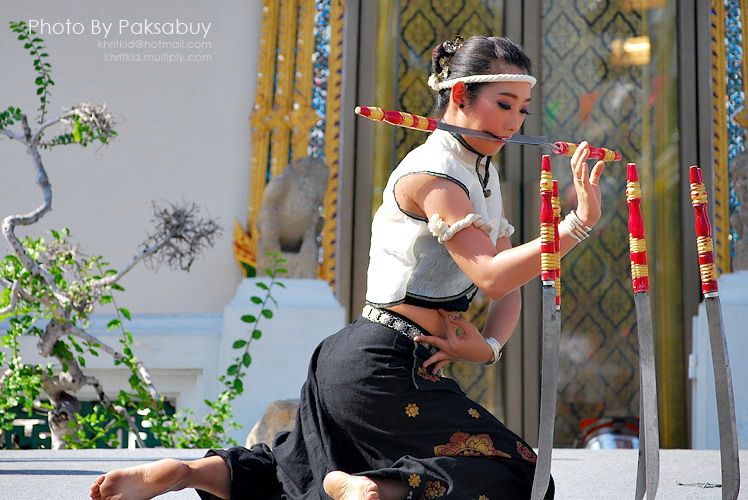
(Photo Credit: Paksabuy)
Values
Learning Jerng is a way for Northern Thai people to preserve the identity and wisdom of their ancestors, whether in the form of pure or applied Jerng. The first and foremost value of Jerng is self-improvement, both physical and mental. Students of Jerng have to prove themselves worthy even before starting the class. They have to cultivate their mind and patience to learn and memorize the moves, and stay calm during as they face opponents in combat, navigating through the other’s puzzling movements. Their health also improves, as strength, agility, and flexibility is increased through trainings.
Jerng teaches practitioners to have respect for their homeland, themselves, and for others. Their skills are used as self-defense, not as weapons to injure others. Jerng practitioners must conduct themselves as respectable members of society. They must protect the young, weak, and old, as well as demonstrate respect for their parents and the elderly. The relationship between disciples and teachers instills the values of gratitude, which is demonstrated mostly clearly through the Wai Khru ceremony.
Jerng today
Nowadays, Jerng is mainly preserved through Forn Jerng, which are used mainly for entertainment purposes. The future of Jerng as a complete marital discipline, however, is still uncertain. More people are needed to learn and preserve the techniques. Twenty years ago, Jerng almost disappeared from Northern Thailand and the memories of the Thai people, but with folk culture making a comeback, Jerng is beginning to gain popularity among the new generation of Lanna. There still are Jerng masters who devote their lives to preserve and spread the beauty of their art by giving classes to children, adults, and foreigners. Jerng has also been incorporated into an exercise routine, which is taught to the public and some schools during physical education classes. Furthermore, the ancient sword art has made a comeback, especially among sword collectors, leading to the founding of the Southeast Asian Weapons Association in Chiang Mai and a sword contest every year.
The greatest obstacle in the perspectives of Jerng masters is that, until Jerng becomes popular, people who practice Jerng will have difficulty making a living. The solution to the survival of Jerng, thus, relies on how to make Jerng an economically viable art so that the art can feed the people who preserve it. Thus, next time you visit Northern Thailand, consider checking out the martial art and supporting Jerng performers. You may even participate in some Jerng lessons if you are interested. Who knows? Perhaps you might even fall in love with this charming fighting style.
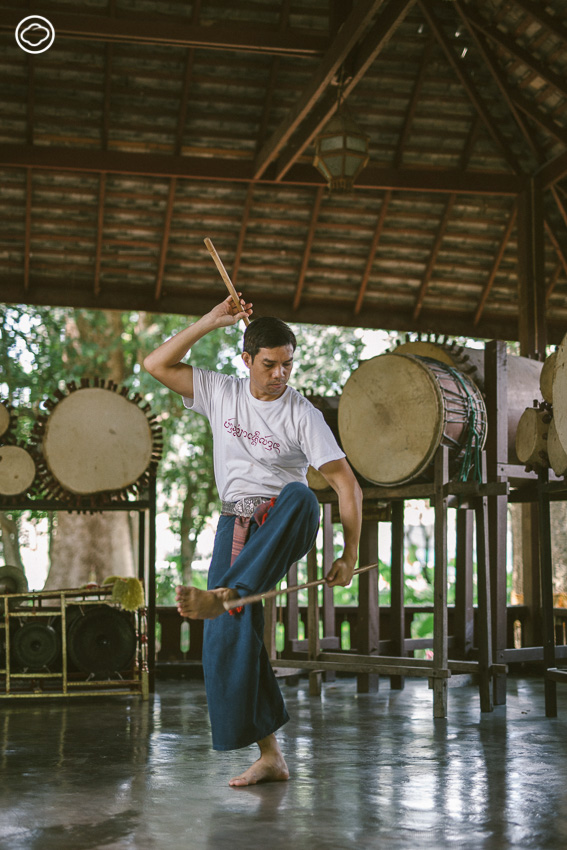
(Photo Credit: The Cloud)
The story of “Jerng” is a lesser-known, yet fascinating, facet of Thai culture and heritage. We saw how the essence of Thainess is represented through the values of respect and self-improvement instilled within practitioners of this martial art. We also see the diversity of cultures within Thailand. Join us in exploring more stories of Thailand and the Thai people, as we take you on a journey to discover Thainess.
Sources
- https://www.youtube.com/watch?v=RzK1FpRWobE
- https://bit.ly/3BOWK3z
- https://bit.ly/3BpL1qP
- http://magazine.culture.go.th/2018/3/mobile/index.html#p=48
- http://magazine.culture.go.th/2014/3/culturemag2014-3/assets/basic-html/index.html#40
________________________________________________________________________________________________
Written by: Soonyata Mianlamai
Edited by: Tayud Mongkolrat
25 October 2022


